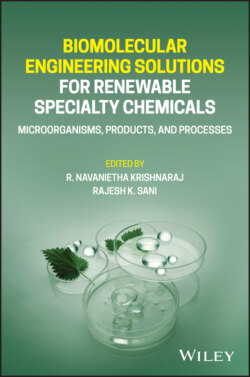Читать книгу Biomolecular Engineering Solutions for Renewable Specialty Chemicals - Группа авторов - Страница 23
1.2.2 Vectors
ОглавлениеA vector is a DNA molecule, which act as molecular transporter, that can replicate autonomously in an appropriate host cell and into which the gene of interest (a foreign gene) is inserted. Insertion of a foreign gene into the vector is aiming either to get numerous copies of the gene of interest or obtaining a product from this gene. Vector is basically of two types: cloning vector and expression vector. Characteristics of an ideal cloning vector are mentioned below:
1 It should have origin of replication, able to replicate autonomously.
2 It should be easily isolated and purified.
3 The vector should have suitable selection marker genes that will allow easy selection of the transformed cells from nontransformed cells.
4 For gene transfer, vector should have the ability to integrate either itself or the DNA insert it carries into the genome of the host cell.
5 The cells transformed with the vector containing the DNA insert should be easily identifiable and selectable from those transformed cells having unaltered vector.
6 Unique restriction digestion sites should be present where gene of interest can be inserted.
Expression vectors are different from cloning vectors. They are designed in such a way that they should have a promoter sequence to express the gene. Expression plasmid has all the information regarding transcription which is followed by translation to synthesize proteins from mRNA. Expression vectors should have the followings gene sequences: A strong promoter for the initiation, termination codon, adaptation of distance between the promoter and cloned gene, incorporated transcription termination sequence, and a compact translation initiation sequence.
Number of cloning vectors are also present which includes plasmid, cosmid, phage vectors, bacterial artificial chromosomes (BACs), and yeast artificial chromosomes (YACs). All the vectors mentioned have different incorporation capacity for foreign DNA. Plasmids are extra chromosomal circular double‐stranded DNA replicating elements present in bacterial cells. Plasmids size is ranging from 5.0 to 400 kb. Plasmids are inserted into bacterial calls by a transformation. Plasmids can incorporate an insert size of up to 10 kb DNA fragment. Bacteriophage infects bacteria and has a very unique mechanism for delivering its genome into bacterial cell. Hence, it can be used as a cloning vector for larger DNA segments insertion. Phage vectors can insert DNA fragments of size up to 20 kb. BACs are simple plasmid vectors that are designed to integrate large DNA fragments of size 75–300 kb (Kim et al., 1996b). BACs have antibiotic resistance marker genes and a very stable OriC that promotes the distribution of plasmid after bacterial cell division and maintaining the plasmid copy number to one or two per cell. YACs are yeast expression vectors. A very large DNA fragments sizes ranging from 100 to 3000 kb can be cloned using YACs (Riley et al., 1990). YACs have an extra benefit over BACs in expressing eukaryotic proteins which need posttranslational modifications.
